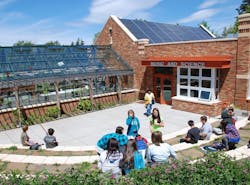Tips to Move Your Building Toward Net Zero
Net zero buildings are becoming the standard for the future. In late August 2018, mayors from 19 cities around the world signed the Net Zero Carbon Buildings Declaration from the C40 Cities Climate Leadership Group. The declaration states that those cities “pledge to enact regulations and/or planning policy to ensure new buildings operate at net zero carbon by 2030 and all buildings by 2050.”
The declaration notes that, because most buildings will be standing for generations to come, action is needed today, providing benefits to the citizens of the cities and occupants of the buildings now and in the future.
If it hasn’t already arrived where you’re located, net zero is on the horizon for both new and existing buildings. Now is the time to consider and plan for it as you look to making updates and improvements.
Net Zero Energy Building Benefits
A building is generally considered net zero energy if it produces as much energy as it consumes, reducing the use and need of nonrenewable energy. This is usually measured over a 12-month period to capture differences related to seasonal effects on a building.
The benefits of a net zero building can be wide-ranging, including:
- Reducing environmental impact (e.g. greenhouse gas and carbon emissions) and increasing resiliency
- Lower operational costs
- Promoting healthier and more comfortable spaces for occupants
- Increased tenant retention and resale/rental values
Common barriers to moving toward a net zero building include the initial investment, and difficulty in finding designers, operators or contractors knowledgeable or experienced in net zero building design and operation.
One way to find someone familiar with net zero energy buildings is by looking at current or completed projects.
Related: Why You Should Consider a Health and Wellness Certification
“A lot of the architects and engineers with experience will advertise their buildings or projects they are working on,” Carbonnier says. “Owners can look to the leaders for guidance because they can demonstrate that they can deliver a zero energy building.”
He also suggests looking at case studies to see if net zero status is for you. New Buildings Institute features case studies ranging from financing, to technologies used and how to benchmark.
“Just by benchmarking alone, buildings typically use less energy because you have that tracking system,” Carbonnier says.
To begin, he suggests a two-step process:
- Benchmark to get a starting point
- Audit the information to get a report and see where you can make improvements
Get Your Facility to Net Zero
The publication “Five Steps to Net Zero Energy” by National Grid and the New Buildings Institute outlines what can be accomplished for anyone looking to get his or her building to zero net energy.
To begin toward net zero energy, do these things:
1. Assess the building. Begin by analyzing energy performance and benchmarking, and finding out how much energy is typical for a building of your type and use. A tool or rating system (e.g. ASHRAE or ENERGY STAR) will help provide context to the information. From there, determine what you are doing well and areas to improve.
2. Set goals for performance. With the assessment information, you can determine what goals to set and how to reach them.
3. Scope the project. The publication encourages looking at other projects and buildings similar to your own to get ideas. One place to start is the New Buildings Institute “Getting to Zero Database.” This will help choose measures that align with your building assessment and goals.
4. Implement the retrofit. This can be disruptive, so consider timing and realities of the building, ownership, tenants and markets when implementing.
5. Operate the building. A successful zero net energy building needs to be operated as such, which begins with design. Include users, operators and contractors in to work with designers on how the building and its spaces are used. And continue to include operation and design going forward.
Transition an Existing Building Toward Net Zero
For an existing building to move toward net zero energy, you will need to perform a retrofit because, in most cases, existing buildings use more energy than they can product on site.
You will need to think about interruptions to the building operation and find non-intrusive solutions to bring energy use down.
On topic: 10 Tips for Green Building Certification
Carbonnier describes a project that the New Buildings Institute is working on to retrofit a building to achieve up to a 20 percent energy savings in a non-intrusive way.
Window Shades
“One way we do that is by putting in window shading,” he says. “That’s a pretty light touch to the building renovation, and it blocks out a lot of the heat gain.”
(Photo: At the Santa Fe Springs office of the California Lottery, skylights bring natural light to interior spaces to reduce the need for artificial lighting. Credit: LPAS Arch+Design)
Plug Loads
Another area to keep an eye on as you move toward lower energy use is plug loads. “As buildings become more efficient, the proportion of a building’s energy use that’s plug loads gets as high as 50 percent or more,” Carbonnier says.
Think about how the occupants of the building are using energy. “For example, if everyone’s charging their laptops or have space heaters and their desk, these can add up to a significant portion of energy use in a low-energy building,” he points out.
For the building to be successful, facility owners and managers need to get buy-in and support from occupants. Carbonnier encourages getting tenants on board by telling them “This is a really high-efficiency building, we are trying to conserve energy” so they understand the goals.
(Photo: A dashboard like the one at the Zero Energy Center in San Leandro, CA, can help make occupants and visitors aware of building metrics. Credit: Chad Ziemendorf)
Making Sense of Financing
From there, align larger energy efficiency projects with major building lifecycle events (e.g. replacing HVAC equipment at the end of its useful life).
“Looking at retrofit projects strategically over time allows building and portfolio owners to plan for their efficiency and renewable energy projects, which can significantly improve project economics,” she says.
Lalit offers financial tips and considerations for a retrofit depending on your facility type:
Owner-occupied Commercial: Secure your capital stack for the retrofit by leveraging energy efficiency and clean energy financing tools like Commercial Property Assessed Clean Energy (C-PACE) to finance the first cost to get to net zero. C-PACE employs a lien on the property and is paid through the property taxes. It can spread the upfront costs of energy efficiency and renewable energy over the equipment lifetime (up to 20 years). The lien can be transferred to the next owner at the time of sale.
Investor-owned, Tenant-occupied: If you’re a building owner leasing your space to tenants, employ creative business models to finance the costs, such as green lease agreements (which typically incorporate cost recovery mechanisms for capital expenditures at a net benefit to tenants, among other features).
Net zero buildings also have financial incentives. Lalit notes that these buildings might have a 3 to 7 percent higher occupancy rate; 3.5 percent higher rental rates; and 13 percent higher sale value.
Making the Financial Case
Including net zero energy improvements or retrofits has many positive effects for a building and the occupants.
However, getting higher ups and decision makers on board financially can be difficult.
Radhika Lalit, senior associate with Rocky Mountain Institute, offers tips on how to make the financial case.
- When looking at retrofits, consider efficiency first, and leverage improvements over time in conjunction with capital upgrades and other building lifecycle events (e.g. boiler or chiller replacements).
- Believe in the productivity benefits of a green building because even a fractional increase in productivity for an owner-occupied commercial building dwarfs the other energy saving and the market differentiation it provides. If the builder intends to lease the space, these increased productivity benefits can translate to higher resale value, better tenant retention and higher rents.
- While energy retrofits have a payback, many other common building improvements have no direct payback (e.g. new lobby, fresh coat of paint). Net zero energy should be a priority, given the business case.
- Building codes will require net zero energy soon. Strategically, net zero energy buildings are the future, especially with policy mandates and codes on buildings tightening each year.
Here’s a list of financial incentives the might help assist you in moving toward net zero energy.
Start Small to See Changes
Make no mistake: the role of a facility manager is changing. Previously, the role was to make sure things weren’t broken and to respond to calls for discomfort so they can change settings.
“The building operator goes from more than just making sure it’s running smoothly to make sure it’s running efficiently, and optimizing the building,” Carbonnier says. “This is a new role for a lot of existing building operators.”
Simple solutions he suggests that you can implement into your facility include:
- Changing computer settings so it goes to sleep after a certain amount of time and isn’t on when not in use
- Setting up a schedule for lighting and the HVAC system, and installing sensors so they are on when people are in the building
“You don’t necessarily need to make your building to zero energy to be successful,” Carbonnier says. “Even if it’s high efficiency, it’s still performing much better than the average building. You will have lower energy and carbon emissions, a more comfortable building, and will be making great contributions for your community and occupants.”
Two handpicked articles to read next:
About the Author

Valerie Dennis Craven
Content strategist and writer
Valerie Dennis Craven is an experienced writer of commercial and residential buildings and interiors, having previously served as Editorial Director for both BUILDINGS and i+s. Valerie enjoys writing about technology and how it impacts users in the built environment.
